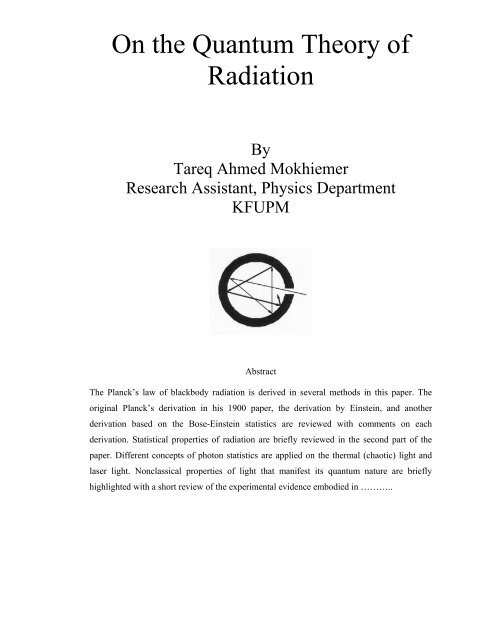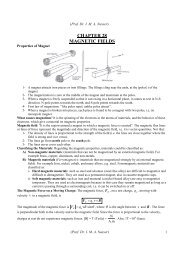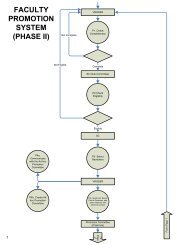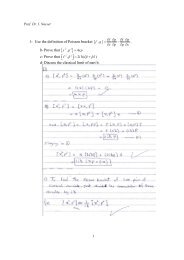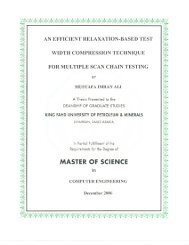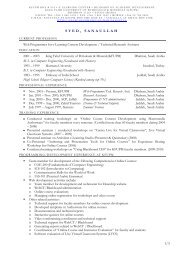On the Quantum Theory of Radiation - KFUPM
On the Quantum Theory of Radiation - KFUPM
On the Quantum Theory of Radiation - KFUPM
Create successful ePaper yourself
Turn your PDF publications into a flip-book with our unique Google optimized e-Paper software.
<strong>On</strong> <strong>the</strong> <strong>Quantum</strong> <strong>Theory</strong> <strong>of</strong><br />
<strong>Radiation</strong><br />
By<br />
Tareq Ahmed Mokhiemer<br />
Research Assistant, Physics Department<br />
<strong>KFUPM</strong><br />
Abstract<br />
The Planck’s law <strong>of</strong> blackbody radiation is derived in several methods in this paper. The<br />
original Planck’s derivation in his 1900 paper, <strong>the</strong> derivation by Einstein, and ano<strong>the</strong>r<br />
derivation based on <strong>the</strong> Bose-Einstein statistics are reviewed with comments on each<br />
derivation. Statistical properties <strong>of</strong> radiation are briefly reviewed in <strong>the</strong> second part <strong>of</strong> <strong>the</strong><br />
paper. Different concepts <strong>of</strong> photon statistics are applied on <strong>the</strong> <strong>the</strong>rmal (chaotic) light and<br />
laser light. Nonclassical properties <strong>of</strong> light that manifest its quantum nature are briefly<br />
highlighted with a short review <strong>of</strong> <strong>the</strong> experimental evidence embodied in ………..
1-Introduction and historical perspective<br />
It was Robert Kirchh<strong>of</strong>f who first argued in 1859 that <strong>the</strong> <strong>the</strong>rmal radiation <strong>of</strong> <strong>the</strong> blackbody<br />
was <strong>of</strong> a fundamental nature. 1 Since that time, several attempts were made to derive a precise<br />
relation that matches <strong>the</strong> experimental results. Wien, suggested that <strong>the</strong> radiation density per<br />
unit frequency per unit volume depended on frequency and temperature by <strong>the</strong> relation u(f,T)<br />
= af 3 exp(bf/T). This law corresponded well with <strong>the</strong> experiment but had no <strong>the</strong>oretical<br />
foundation 1 . Rayleigh and James Jeans analyzed <strong>the</strong> problem from a classical point <strong>of</strong> view<br />
and <strong>the</strong>y came up with a relation that was drastically different than experiment (<strong>the</strong><br />
ultraviolet catastrophe). This contradiction was an indication <strong>of</strong> some problems in classical<br />
physics. It was Max Planck who first reached a sound pro<strong>of</strong> <strong>of</strong> <strong>the</strong> radiation density formula<br />
based on <strong>the</strong> statistical definition <strong>of</strong> <strong>the</strong> entropy and its relation to <strong>the</strong> energy and<br />
temperature. Planck had to assume that <strong>the</strong> energies <strong>of</strong> <strong>the</strong> harmonic oscillators that emit <strong>the</strong><br />
radiation are quantized to arrive at <strong>the</strong> correct relation that describes <strong>the</strong> experimental<br />
observations at short and long wavelengths.<br />
Einstein’s work on <strong>the</strong> photoelectric effect and <strong>the</strong> specific heat <strong>of</strong> metals, has drawn <strong>the</strong><br />
attention to <strong>the</strong> role that <strong>the</strong> <strong>the</strong>ory <strong>of</strong> quanta may play in physics. As a response to <strong>the</strong>se<br />
radical developments in physics, a conference was held in Solvay in 1911, on "radiation<br />
<strong>the</strong>ory and <strong>the</strong> quanta" to discuss <strong>the</strong> emerging quantum <strong>the</strong>ory. Henri Poincare was one <strong>of</strong><br />
<strong>the</strong> attendants <strong>of</strong> this conference. Although he spent most <strong>of</strong> his life as a classical physicist<br />
and a prominent ma<strong>the</strong>matician, he became excited by <strong>the</strong> idea <strong>of</strong> quantization. Unsatisfied<br />
by Planck’s pro<strong>of</strong> <strong>of</strong> <strong>the</strong> blackbody radiation formula, he worked on his own pro<strong>of</strong>. In his last<br />
memoir, written six months before his death, Poincare tried to prove that not only<br />
quantization was a sufficient condition for deriving <strong>the</strong> blackbody radiation formula, but also<br />
a necessary condition. The blackbody radiation formula remains today as important as it was<br />
in <strong>the</strong> beginning <strong>of</strong> <strong>the</strong> twentieth century, since it has opened <strong>the</strong> door for ‘fur<strong>the</strong>r<br />
quantization’ and <strong>the</strong> beginning <strong>of</strong> <strong>the</strong> quantum mechanics.<br />
2-Planck’s derivation<br />
In his famous paper, Planck used <strong>the</strong> model <strong>of</strong> harmonic oscillators for <strong>the</strong> frequencies <strong>of</strong> <strong>the</strong><br />
radiation. His motivation to use <strong>the</strong> model <strong>of</strong> a harmonic oscillator may be to model <strong>the</strong><br />
dipole radiation where charge oscillation leads to <strong>the</strong> emission <strong>of</strong> electromagnetic waves. It<br />
was known that such Hertzian resonators by virtue <strong>of</strong> <strong>the</strong>ir vibration, radiate hertzian(<br />
Electromagnetic) waves. 7 The simplest mechanical model that has oscillation is <strong>the</strong> harmonic<br />
oscillator. These oscillators were thought to exist in <strong>the</strong> walls <strong>of</strong> <strong>the</strong> cavity (what we now<br />
know to be atoms). It’s not clear to me however why Planck opted to use N harmonic
oscillator for each frequency and not a single one. Planck started by stating cleverly that a<br />
single harmonic oscillator with constant phase and amplitude has zero entropy since it’s in<br />
complete order (and entropy is a measure <strong>of</strong> <strong>the</strong> amount <strong>of</strong> disorder). In his own words,<br />
Planck said: “Entropy depends on disorder and this disorder, according to <strong>the</strong><br />
electromagnetic <strong>the</strong>ory <strong>of</strong> radiation for <strong>the</strong> monochromatic vibrations <strong>of</strong> a resonator when<br />
situated in a permanent stationary radiation field, depends on <strong>the</strong> irregularity with which it<br />
constantly changes its amplitude and phase, provided one considers time intervals large<br />
compared to <strong>the</strong> time <strong>of</strong> one vibration but small compared to <strong>the</strong> duration <strong>of</strong> a measurement.<br />
If amplitude and phase both remained absolutely constant, which means completely<br />
homogeneous vibrations, no entropy could exist and <strong>the</strong> vibrational energy would have to be<br />
completely free to be converted into work.” However as we will see later at <strong>the</strong> end <strong>of</strong> his<br />
pro<strong>of</strong>, <strong>the</strong> single harmonic oscillator turned out to have a nonzero entropy. To prove his<br />
famous relation, Planck had to quantize <strong>the</strong> energy <strong>of</strong> <strong>the</strong> oscillators and consider many<br />
harmonic oscillators instead <strong>of</strong> only one and calculate <strong>the</strong> entropy by counting <strong>the</strong> number <strong>of</strong><br />
ways by which <strong>the</strong> total energy can be distributed among <strong>the</strong>se oscillators( <strong>the</strong> number <strong>of</strong><br />
possible microstates).<br />
By assuming that <strong>the</strong> energy quantum = ε and <strong>the</strong> total energy UN=P ε, <strong>the</strong> number <strong>of</strong> ways<br />
to distribute P quanta among N distinguishable oscillators is given by:<br />
( N + P −1)!<br />
R =<br />
P!(<br />
N −1)!<br />
Then <strong>the</strong> enropy directly follows from Boltzmann’s law as SN= k log R<br />
SN = k { (N + P) log (N + P) - N log N - P log P} and in terms <strong>of</strong> U, e <strong>the</strong> entropy can be<br />
written as:<br />
And <strong>the</strong> entropy <strong>of</strong> a single harmonic oscillator is given by <strong>the</strong> previous quantity divided by<br />
N, namely:<br />
How did Planck explain <strong>the</strong> source <strong>of</strong> <strong>the</strong> entropy (disorder) in <strong>the</strong> single oscillator, in<br />
contrast to what he mentioned in <strong>the</strong> beginning <strong>of</strong> his article If he was asked that question<br />
after 1927, he may have said it is due to <strong>the</strong> uncertainty relation between <strong>the</strong> two conjugate
variable P, Q in <strong>the</strong> harmonic oscillator, but what if he was asked in 1900 How could he<br />
reach <strong>the</strong> same result if he starte by a single harmonic oscillator (i.e, N=1) <br />
A direct application <strong>of</strong> <strong>the</strong> relation between Temperature, entropy, and Energy <strong>of</strong> a single<br />
ε<br />
1 dS<br />
U =<br />
ε<br />
=<br />
θ<br />
oscillator θ dU to <strong>the</strong> previous equation yields directly e k −1<br />
. Then as Einstein did,<br />
Planck made use <strong>of</strong> Wien’s law to derive <strong>the</strong> specific relation between <strong>the</strong> quantum ε<br />
and <strong>the</strong> frequency <strong>of</strong> <strong>the</strong> oscillator ν. Wien’s law implies that <strong>the</strong> relation between <strong>the</strong> energy<br />
density u, and <strong>the</strong> frequency and temperatures is given by:<br />
Using <strong>the</strong> relation between <strong>the</strong> radiation density and <strong>the</strong> energy <strong>of</strong> <strong>the</strong> single oscillator that<br />
2<br />
8πν<br />
Planck derived in an earlier paper u = U , he could rewrite Wien’s law in <strong>the</strong> form<br />
3<br />
c<br />
By comparing this relation with <strong>the</strong> expression for U derived earlier, it’s seen that <strong>the</strong> energy<br />
<strong>of</strong> <strong>the</strong> smallest quantum is given by ε = hν<br />
, where h is a universal constant.<br />
Combining <strong>the</strong> previous result and <strong>the</strong> expression <strong>of</strong> <strong>the</strong> radiation density which is <strong>the</strong><br />
energy per unit volume per unit frequency interval we obtain <strong>the</strong> famous Planck law<br />
In <strong>the</strong> time Planck intrduced this assumption <strong>of</strong> <strong>the</strong> quantization <strong>of</strong> <strong>the</strong> energy <strong>of</strong> a harmonic<br />
oscillator, nobody noticed how pr<strong>of</strong>ound this assumption was in <strong>the</strong> physics. I don’t why<br />
didn’t Planck continue in <strong>the</strong> same line <strong>of</strong> thought and ask himself immediately how or why<br />
was <strong>the</strong> energy <strong>of</strong> <strong>the</strong> harmonic oscillator quantized It was not before 25 years later that <strong>the</strong><br />
real reason <strong>of</strong> quantizing <strong>the</strong> energy <strong>of</strong> <strong>the</strong> harmonic oscillator was rigoursly derived from <strong>the</strong><br />
postulates <strong>of</strong> quantum mechanics.<br />
3- Einstein derivation <strong>of</strong> Planck’s radiation law<br />
Although <strong>the</strong> famous paper in which Einstein introduced <strong>the</strong> A, B coefficients was written<br />
mainly to derive <strong>the</strong> Planck’s radiation law for <strong>the</strong> blackbody problem, this derivation is<br />
usually forgotten and <strong>the</strong> paper is remembered only for laying <strong>the</strong> foundations for <strong>the</strong><br />
operation <strong>of</strong> <strong>the</strong> laser. The derivation goes as follows:<br />
Einstein assumed that <strong>the</strong> atoms <strong>of</strong> <strong>the</strong> walls <strong>of</strong> <strong>the</strong> blackbody are two-level atoms where<br />
<strong>the</strong>y can absorb or emit quanta <strong>of</strong> energy equal <strong>the</strong> same amount as <strong>the</strong> difference between<br />
<strong>the</strong> two levels. Each atom has an absorption and emission probability Pa, Pe given by
Where<br />
ρν<br />
is <strong>the</strong> density <strong>of</strong> electromagnetic radiation in <strong>the</strong> cavity, Ba and Be are<br />
undetermined coefficients for absorption and stimulated emission, respectively, and A is <strong>the</strong><br />
coefficient for spontaneous emission. a<br />
Let <strong>the</strong> number <strong>of</strong> atoms per unit volume in <strong>the</strong><br />
excited state and ground state be n e , n g respectively. The detailed balance condition which<br />
results from <strong>the</strong> <strong>the</strong>rmal equilibrium between <strong>the</strong> radiation and <strong>the</strong> atoms states that <strong>the</strong><br />
probability that an atom in <strong>the</strong> ground state gets excited equals <strong>the</strong> probability that an excited<br />
atom emits <strong>the</strong> photon and decays to <strong>the</strong> ground state. This condition can be expressed as:<br />
Then Einstein assumed that <strong>the</strong> atoms <strong>the</strong>mselves are in <strong>the</strong>rmal equilibrium b and he used<br />
<strong>the</strong> partition function derived from <strong>the</strong> canonical ensemble to write <strong>the</strong> ratio between n e and<br />
n g as<br />
ρ<br />
Solving <strong>the</strong> four previous equations for<br />
ν<br />
we find that<br />
Which is indeed similar to Planck’s formula. Next, Einstein made use <strong>of</strong> <strong>the</strong> results reached<br />
by Rayleigh about <strong>the</strong> relation between <strong>the</strong> radiation density and <strong>the</strong> frequency at long<br />
wavelengths and high temperatures namely<br />
This limit can be indeed satisfied if we choose Ba=Be=B where <strong>the</strong> radiation density will be<br />
in <strong>the</strong> form<br />
ε<br />
ρ ν<br />
= A/<br />
B<br />
kT . To determine <strong>the</strong> dependence <strong>of</strong> A/B and ε on frequency,<br />
Einstein used ano<strong>the</strong>r law that states that<br />
ρν<br />
has a scaling dependence on <strong>the</strong> variables υ and<br />
T,( Wien’s displacement law) <strong>of</strong> <strong>the</strong> form<br />
a 6A. Einstein, ‘‘Zur Quanten<strong>the</strong>orie der Strahlung,’’ Phys. Z. 18, 121–128 ~1917<br />
b The atoms <strong>of</strong> course are continuously absorbing and emitting photons, but since <strong>the</strong>y are in equilibrium with<br />
<strong>the</strong> radiation, <strong>the</strong>ir total energy is fixed and hence <strong>the</strong>y can be considered as an isolated ensemble.
To satisfy this equation <strong>the</strong> only choices for A/B and ε will be<br />
Where h, α are universal constants. Finally <strong>the</strong> energy density <strong>of</strong> <strong>the</strong> radiation will look like<br />
ρ =<br />
ν<br />
3<br />
αν<br />
e<br />
hν<br />
kT<br />
−1<br />
We note here that <strong>the</strong> nonclassical assumption in Einstein derivation is <strong>the</strong> stationary energy<br />
states <strong>of</strong> <strong>the</strong> atom. 9<br />
It’s worth mentioning here as we noted in <strong>the</strong> Planck’s derivation that <strong>the</strong> elements <strong>of</strong> <strong>the</strong><br />
canonical ensemble (which are atoms in our case) have to be able to exchange <strong>the</strong> quanta <strong>of</strong><br />
energy between each o<strong>the</strong>r. This is done in our case by atoms emitting photons that are<br />
absorbed by o<strong>the</strong>r atoms. We note also that <strong>the</strong> atoms were assumed to have two level only<br />
while <strong>the</strong> fact that <strong>the</strong> spectrum <strong>of</strong> <strong>the</strong> blackbody radiation is continuous in frequency<br />
necessitates that all frequency resonances have to be present in <strong>the</strong> atoms <strong>of</strong> <strong>the</strong> wall and not<br />
only a discrete set <strong>of</strong> <strong>the</strong>m. I think this problem is resolved by <strong>the</strong> presence <strong>of</strong> broadening<br />
mechanisms that leads eventually to <strong>the</strong> continuous spectrum. But shouldn’t <strong>the</strong> different<br />
intensities <strong>of</strong> different lines affect <strong>the</strong> radiation spectrum <strong>of</strong> <strong>the</strong> blackbody<br />
3-Third derivation using Bose-Einstein statistics<br />
A third derivation in which Pathria in his book attributed to Einstein, uses <strong>the</strong> Bose-Einstein<br />
statistics for <strong>the</strong> grand canonical ensemble. Here <strong>the</strong> radiation in <strong>the</strong> cavity is treated as a gas<br />
<strong>of</strong> indistinguishable photons obeying Bose statistics, namely <strong>the</strong> expectation number <strong>of</strong> <strong>the</strong><br />
photons occupying a certain energy level ε is given by<br />
< nε<br />
>=<br />
ε / kT<br />
e<br />
1<br />
. However several<br />
−1<br />
comments are in order here. First, <strong>the</strong> postulate <strong>of</strong> equal apriori probabilities implies that <strong>the</strong><br />
system will be in <strong>the</strong> macrostate (e.g, E) that has <strong>the</strong> largest number <strong>of</strong> microstates. This is<br />
based on <strong>the</strong> assumption that at <strong>the</strong> same macrostate, <strong>the</strong> system can jump freely between<br />
different allowed microstates without restriction. For <strong>the</strong> case <strong>of</strong> ideal gas, <strong>the</strong>se microstates<br />
may correspond to different energy distributions between <strong>the</strong> particles (or different space<br />
configurations). This <strong>of</strong> course requires a means <strong>of</strong> energy transfer between <strong>the</strong> particles<br />
which truly exists in <strong>the</strong> ideal gas through collisions. But what about <strong>the</strong> system <strong>of</strong> bosonic<br />
photons we have here How can <strong>the</strong> system jump from one microstate to ano<strong>the</strong>r and how
can <strong>the</strong> photons exchange energy with one ano<strong>the</strong>r c As for <strong>the</strong> chemical potential, Pathria<br />
set it to zero. He said that because <strong>the</strong> number <strong>of</strong> photons is indefinite since photons are<br />
being absorbed and emitted from <strong>the</strong> walls continously, but isn't this <strong>the</strong> case for <strong>the</strong> grand<br />
canonical ensemble Moreover I expect that at equilibrium <strong>the</strong> number <strong>of</strong> photons is fixed<br />
and not indefinite as Pathria stated, and hence we should use <strong>the</strong> canonical distribution ra<strong>the</strong>r<br />
than <strong>the</strong> grand canonical. However regardless <strong>of</strong> <strong>the</strong> type <strong>of</strong> <strong>the</strong> ensemble we use, <strong>the</strong> most<br />
probable value for n ε<br />
calculated without referring to a certain ensemble has <strong>the</strong> same value<br />
as < n ε<br />
> . But still I couldn’t find a satisfactory explanation <strong>of</strong> setting <strong>the</strong> chemical potential<br />
<strong>of</strong> photons to zero. Next steps in this derivations are to calculate <strong>the</strong> density <strong>of</strong> states<br />
2<br />
dq<br />
g ( ω)<br />
dω . In terms <strong>of</strong> <strong>the</strong> phase space = ∫<br />
3 4πp<br />
dp<br />
g(<br />
ω ) dω<br />
2<br />
where <strong>the</strong> factor 2 is used to<br />
3<br />
h<br />
account for two perpendicular directions <strong>of</strong> polarizations <strong>of</strong> <strong>the</strong> photon spin. Using <strong>the</strong><br />
ω<br />
relation between momentum and frequency p = we find that<br />
c<br />
V ⎪⎧<br />
⎛<br />
⎫<br />
g(<br />
ω ) dω<br />
= 2 4π<br />
=<br />
3 ⎨ ⎜<br />
h ⎪⎩ ⎝ c ⎠ ⎝ c ⎠⎪⎭<br />
2<br />
2<br />
ω<br />
⎞ ⎛ dω<br />
⎞⎪<br />
Vω<br />
dω<br />
⎟ ⎜ ⎟⎬<br />
d By expressing <strong>the</strong> energy level ε<br />
2 3<br />
π c<br />
as ε = ω<br />
we get exactly <strong>the</strong> same relation <strong>of</strong> <strong>the</strong> radiation density as that <strong>of</strong> Planck.<br />
It’s interesting that <strong>the</strong> assumption <strong>of</strong> <strong>the</strong> quantized nature <strong>of</strong> radiation inside <strong>the</strong> cavity (that<br />
light waves are made up <strong>of</strong> particles called photons) is sufficient to impose <strong>the</strong> quantized<br />
energy levels on atoms in equilibrium with light.<br />
4- Poincaré's last memoir on <strong>the</strong> quantum discontinuity <strong>of</strong> nature<br />
Here I’m going to comment on ano<strong>the</strong>r pro<strong>of</strong> <strong>of</strong> <strong>the</strong> quantum nature <strong>of</strong> light initiated by <strong>the</strong><br />
famous French ma<strong>the</strong>matician and physicist Henri Poincare. Since Poincare spent most <strong>of</strong> his<br />
life as a certified master <strong>of</strong> classical physics one would expect that he would be very<br />
reluctant at <strong>the</strong> age <strong>of</strong> 57 to change his mind about <strong>the</strong> nature <strong>of</strong> continuity <strong>of</strong> matter and<br />
radiation. However upon attending <strong>the</strong> Solvay conference that was held specially to<br />
investigate <strong>the</strong> new ideas <strong>of</strong> <strong>the</strong> quantum nature <strong>of</strong> light and to shed more light on <strong>the</strong><br />
blackbody radiation, <strong>the</strong> “most mysterious phenomenon and a most difficult one to unveil”<br />
he was very enthusiastic upon <strong>the</strong> new idea and actively participated on <strong>the</strong> discussions.<br />
After <strong>the</strong> conference, Poincare returned to Paris and became engaged with <strong>the</strong> quantum<br />
problem. In accord to my objection to <strong>the</strong> third pro<strong>of</strong> given above, Poincare considered<br />
Planck’s pro<strong>of</strong> lacking a very important component, <strong>the</strong> mechanism to achieve equilibrium<br />
between in <strong>the</strong> system <strong>of</strong> harmonic oscillators. In his own words, Poincare wrote: “For a<br />
c Let alone o<strong>the</strong>r systems we studied in <strong>the</strong> course like a system <strong>of</strong> magnetic dipoles for example.<br />
d Pathria,7.2.6
(equilibrium) distribution to take place between <strong>the</strong> resonators <strong>of</strong> different wavelengths<br />
whose oscillations are <strong>the</strong> cause <strong>of</strong> radiation, <strong>the</strong> resonators must be capable <strong>of</strong> exchanging<br />
<strong>the</strong>ir energy. O<strong>the</strong>rwise, <strong>the</strong> initial distribution will persist indefinitely and this initial<br />
distribution is arbitrary, <strong>the</strong>re could be no unique law <strong>of</strong> radiation.”<br />
However, I don’t agree with that since Planck had to assume only that harmonic oscillators <strong>of</strong><br />
<strong>the</strong> same frequency are in equilibrium. . In this case energy can be transferred between <strong>the</strong>m<br />
without any problem since <strong>the</strong>y are in resonance with one ano<strong>the</strong>r There is no need to find a<br />
mechanism for exchanging energy between oscillators <strong>of</strong> different frequencies. To provide<br />
this mechanism, Poincare modeled <strong>the</strong> interaction between harmonic oscillators as mediated<br />
by a medium <strong>of</strong> freely moving atoms which collide with <strong>the</strong> resonators.<br />
5- <strong>Quantum</strong> statistics <strong>of</strong> photons<br />
The quantum first order degree <strong>of</strong> coherence which identifies <strong>the</strong> degree <strong>of</strong> correlation<br />
between <strong>the</strong> light fields at two space time points (r 1 ,t 1 ) and (r 2 ,t 2 ) is defined by<br />
<br />
− +<br />
E ( r<br />
(1)<br />
1t1)<br />
E ( r2t<br />
2<br />
)<br />
g ( r1t<br />
1,<br />
r2t<br />
2<br />
) =<br />
<br />
− +<br />
−<br />
+<br />
E ( r t ) E ( r t ) E ( r t ) E ( r t )<br />
1<br />
[<br />
1 1 1 1<br />
2 2 2 2<br />
] 2<br />
Where E<br />
r t ), E<br />
− + ( r ) are <strong>the</strong> electric field operators. The subscripts designating a certain<br />
(<br />
1 1 2t2<br />
mode and polarization <strong>of</strong> <strong>the</strong> field have been omitted to simplify notation. A fuller<br />
representation <strong>of</strong> <strong>the</strong> electric field operator is given by<br />
<br />
− <br />
+ <br />
E <br />
<br />
( r,<br />
t)<br />
= E k , σ ( r,<br />
t)<br />
+ E k , σ ( r,<br />
t)<br />
k , σ<br />
<br />
<br />
+ <br />
<br />
C aˆ<br />
exp( i t ik.<br />
r ) aˆ<br />
<br />
= − ω + − k , σ exp( iωt<br />
− ik.<br />
r )<br />
[ ]<br />
k , σ<br />
The expectation values are calculated using <strong>the</strong> density operator,<br />
<br />
− + <br />
− +<br />
E r t ) E ( r t ) = Tr ρ E ( r t ) E ( r )<br />
( )<br />
(<br />
1 1 1 1<br />
1 1 1t1<br />
(1)<br />
The quantity g r t r t ) signifies <strong>the</strong> ability <strong>of</strong> <strong>the</strong> light at <strong>the</strong> two space time points to form<br />
(<br />
1 1, 2 2<br />
interference fringes when superimposed. By expanding <strong>the</strong> expressions <strong>of</strong> <strong>the</strong> field operator,<br />
<br />
r1<br />
− r2<br />
it can be seen that <strong>the</strong> coherence function is a function <strong>of</strong> <strong>the</strong> parameter τ = t2<br />
− t1<br />
+ ,<br />
c<br />
(1)<br />
hence it can be written for short as g ( τ ) . First order coherence has similar properties in<br />
(1)<br />
classical and quantum representations <strong>of</strong> light. g ( τ ) has <strong>the</strong> same numerical range in both<br />
(1)<br />
schemes, namely 1 ≥ g ( τ ) ≥ 0 . The interference pattern which is a result <strong>of</strong> <strong>the</strong> first order<br />
coherence can be obtained using both treatments. However more striking differences occur in<br />
measurements that depend on second order coherence. 3<br />
In a similar way <strong>the</strong> quantum degree <strong>of</strong> second order coherence is defined as
g<br />
(2)<br />
( rt<br />
r t ; r t<br />
1 1, 2 2<br />
2 2,<br />
<br />
− − + +<br />
E ( rt<br />
1 1)<br />
E ( r2t<br />
2)<br />
E ( rt<br />
1 1)<br />
E ( r2t<br />
2)<br />
rt<br />
1 1)<br />
= <br />
− +<br />
− +<br />
E ( rt ) E ( rt ) E ( r t ) E ( r t )<br />
1 1<br />
1 1<br />
2 2<br />
The second order coherence defines <strong>the</strong> correlation between <strong>the</strong> light intensities in two<br />
different space time points. With intensities measured by phototubes, <strong>the</strong> correlation is<br />
proportional to <strong>the</strong> transition rate <strong>of</strong> <strong>the</strong> joint absorption <strong>of</strong> photons at <strong>the</strong> two space time<br />
points. 3 Note that <strong>the</strong> sequence <strong>of</strong> operators matters in this definition, i.e, annihilation<br />
operators to <strong>the</strong> left. The second order coherence can be measured in a photon beam at <strong>the</strong><br />
same loction using a single photon detector by counting <strong>the</strong> numbers <strong>of</strong> photons registered by<br />
<strong>the</strong> detector in brief in two brief intervals separated by timeτ , <strong>the</strong>n <strong>the</strong> second order<br />
coherence is given by <strong>the</strong> correlation between <strong>the</strong> photon numbers as<br />
g<br />
(2)<br />
( τ ) = n(0)<br />
n(<br />
τ ) / n<br />
2<br />
2 2<br />
6-Thermal (chaotic) photon states<br />
Since photons are bosons, <strong>the</strong>y follow Bose-Einstein statistics and <strong>the</strong> probability <strong>of</strong><br />
occupying <strong>the</strong> mode <strong>of</strong> energy ε is given by (See Pathria 6.4.10)<br />
ε<br />
−βε<br />
n<br />
( e )<br />
−βε<br />
( 1−<br />
e )<br />
P ( n)<br />
= , and since <strong>the</strong> mean number <strong>of</strong> photons is given by<br />
The probability to detect n photons in a small time τ , P(n) can be written as<br />
n<br />
P ( n)<br />
=<br />
n+<br />
n<br />
( 1+<br />
n ) 1<br />
1<br />
n = βε<br />
, <strong>the</strong>n e −1<br />
Hence, <strong>the</strong> density operator <strong>of</strong> a single mode <strong>of</strong> <strong>the</strong>rmal (blackbody) radiation is described by<br />
1<br />
−<br />
2 + n<br />
Where n = ( n!)<br />
( a ) 0 and n is <strong>the</strong> mean number <strong>of</strong> photons detected in a certain time<br />
(τ) and is given by<br />
And Z is <strong>the</strong> partition function given by :<br />
And n is <strong>the</strong> number state <strong>of</strong> a single mode
The variance <strong>of</strong> <strong>the</strong> photon number in <strong>the</strong>rmal states is given by<br />
7-Photon statistics <strong>of</strong> a coherent source<br />
A coherent source emits photons in states <strong>of</strong> a coherent superposition <strong>of</strong> number states in <strong>the</strong><br />
form<br />
Where α in general is a complex number. Laser beams are best characterized by <strong>the</strong>se states<br />
since <strong>the</strong>y have <strong>the</strong> minimum amount <strong>of</strong> uncertainty in <strong>the</strong> phase and amplitude. The mean<br />
number <strong>of</strong> photons in <strong>the</strong> coherent states n is given by <strong>the</strong> relation<br />
And <strong>the</strong> probability to detect n photons P(n) is<br />
We notice that this is a Poissonian distribution. We remember that this distribution is<br />
characteristic <strong>of</strong> processes involving <strong>the</strong> occurrence <strong>of</strong> discrete events happening independent<br />
<strong>of</strong> each o<strong>the</strong>r. Thus, in a coherent state photons behave like <strong>the</strong>y were uncorrelated classical<br />
objects! In contrast to naive expectations, <strong>the</strong> photons in a (single mode) laser (and well<br />
above <strong>the</strong> threshold) arrive in a random fashion; in particular <strong>the</strong>y do not “ride” on <strong>the</strong><br />
electrical field maxima. 8 The counting statistics are <strong>the</strong> same as <strong>the</strong> statistics <strong>of</strong> telephone<br />
calls arriving at a switchboard or web pages requests from a web server.<br />
As in possonian distribution, <strong>the</strong> variance <strong>of</strong> <strong>the</strong> number <strong>of</strong> detected photons ∆n<br />
is given by<br />
<strong>the</strong> relation<br />
∆n 2 = n . A coherent state <strong>of</strong> radiation is first order coherent, that is<br />
g<br />
(1)<br />
( τ )<br />
= 1for all pairs <strong>of</strong> space time points. A comparison between <strong>the</strong> photo-count<br />
distribution <strong>of</strong> <strong>the</strong> <strong>the</strong>rmal (chaotic) light and <strong>the</strong> coherent light is illustrated in figure( )
The photo-count distribution in this graph is obtained experimentally by letting <strong>the</strong> light fall<br />
on a photo-detector through a shutter that is open for a very short interval. And counting <strong>the</strong><br />
number <strong>of</strong> photons registered by <strong>the</strong> photo-detector. This measurement is repeated many<br />
times and a time delay is allowed between successive measurements. This delay should be<br />
long compared to <strong>the</strong> coherent time <strong>of</strong> <strong>the</strong> light.<br />
It’s interesting to note that <strong>the</strong> photon count distribution <strong>of</strong> both coherent and chaotic light<br />
can also be obtained from o<strong>the</strong>r arguments as Loudon did in 6.6, 6.7 in his book. The only<br />
assumption made are that <strong>the</strong> number <strong>of</strong> photons detected by <strong>the</strong> photodetctor is proportional<br />
to <strong>the</strong> intensity <strong>of</strong> <strong>the</strong> light, and ano<strong>the</strong>r assumption pertinent to <strong>the</strong> type <strong>of</strong> radiation. For<br />
coherent radiation <strong>the</strong> o<strong>the</strong>r assumption is that <strong>the</strong> intensity <strong>of</strong> light is independent <strong>of</strong> time,<br />
while for chaotic light <strong>the</strong> intensity has a Gaussian distribution and <strong>the</strong> averaging process<br />
over time is equivalent to <strong>the</strong> ensemble averging by <strong>the</strong> ergodicity <strong>the</strong>orem. The derivation is<br />
lengthy and can be reviewed from Loudon’s book.<br />
It’s worth mentioning that <strong>the</strong>rmal photon statistics can be obtained by a superposition <strong>of</strong><br />
many coherent states in which α changes randomly in Gaussian distribution given by<br />
And hence <strong>the</strong> density operator will be given by<br />
Where n is given by<br />
A comparison between <strong>the</strong> distribution <strong>of</strong> α in <strong>the</strong> coherent (laser) source and <strong>the</strong> <strong>the</strong>rmal<br />
source is shown in figure()<br />
Ano<strong>the</strong>r important aspect in <strong>the</strong> comparison between chaotic light and laser is <strong>the</strong> bunching<br />
effect.
Photon bunching is <strong>the</strong> tendency <strong>of</strong> photons to group toge<strong>the</strong>r in bunches, if <strong>the</strong> photodetctor<br />
detected n photons, it’s more probable that <strong>the</strong>se n photons reached <strong>the</strong> photodetector close to<br />
each o<strong>the</strong>r than spread in time.<br />
(2)<br />
As shown in figure ( ), chaotic light has strong correlation g ( τ ) at shorter times that<br />
decreases as τ increases, while <strong>the</strong> photons <strong>of</strong> <strong>the</strong> laser beam arrive at <strong>the</strong> photodetector<br />
uncorrelated-as mentioned before- an exhibits no bunching.<br />
8- Non-classical properties <strong>of</strong> light<br />
Now we turn our attention to two o<strong>the</strong>r distributions <strong>of</strong> light that are manifestations <strong>of</strong> certain<br />
nonclassical states <strong>of</strong> light, namely photon anti-bunching and sub-poissonian photon<br />
statistics.<br />
Anti-bunching is <strong>the</strong> opposite effect i.e., <strong>the</strong> photons prefer to come not too close. In a<br />
quantitative manner, photon anti-bunching occurs <strong>of</strong> <strong>the</strong> second order coherence increases<br />
from its initial value at τ = 0<br />
11 or equivalently<br />
(2)<br />
Ano<strong>the</strong>r criterion for photon anti-bunching is 1 > g (0) ≥ 0<br />
Histogram <strong>of</strong> time delays between consecutive photon pairs in photon anti-bunched beam is<br />
shown in figure()
The phenomenon <strong>of</strong> anti-bunching or anti-correlation is used as an evidence for <strong>the</strong> quantum<br />
nature <strong>of</strong> radiation in some experiments. 12<br />
Unlike Poissonian photon statistics, sub-Poisson photon statistics is a photon number<br />
distribution for which <strong>the</strong> variance is less than <strong>the</strong> mean and super-Poisson statistics is a<br />
photon number distribution for which <strong>the</strong> variance is greater than <strong>the</strong> mean. Both photon<br />
count statistics compared to Poisson statistics are shown in <strong>the</strong> figure()<br />
It has been shown by Mandel and Zou 10 that <strong>the</strong>se two nonclassical phenomena are not<br />
related and needn’t occur toge<strong>the</strong>r as it was thought previously by some authors.<br />
9-Conclusion<br />
The quantization <strong>of</strong> <strong>the</strong> electromagnetic energy, had <strong>the</strong> pr<strong>of</strong>ound impact to quantize many<br />
o<strong>the</strong>r quantities.<br />
10-References<br />
1- Max Planck: <strong>the</strong> reluctant revolutionary, Helge Kragh, Physics World, December<br />
2000.<br />
2- 100 Years <strong>of</strong> Light Quanta, Roy J. Glauber, Nobel Lecture<br />
3- The <strong>Quantum</strong> <strong>Theory</strong> <strong>of</strong> Light, 2nd edition, Roudney Loudon.<br />
4- <strong>On</strong> <strong>the</strong> Law <strong>of</strong> Distribution <strong>of</strong> Energy in <strong>the</strong> Normal Spectrum, Max Planck Annalen<br />
der Physik<br />
vol. 4, p. 553 ff (1901)<br />
5- The evolution <strong>of</strong> radiation toward <strong>the</strong>rmal equilibrium: A soluble model that<br />
illustrates <strong>the</strong> foundations <strong>of</strong> statistical mechanics, Michael Nauenberg, Am. J. Phys.<br />
72 ~3!, March 2004
6- Statistical Mechanics, 2nd edition, Pathria<br />
7- Poincaré's pro<strong>of</strong> <strong>of</strong> <strong>the</strong> quantum discontinuity <strong>of</strong> nature Jeffrey J. Prentis Am. J.<br />
Phys. 63, 339 (1995)<br />
8- Photons and Photon Statistics: From Incandescent Light to Lasers, Ralph v. Baltz<br />
9- Einstein’s derivation <strong>of</strong> Planck’s radiation law, Henry R. Lewis, Am. J. Phys. 41,<br />
January 1973<br />
10- Photon-antibunching and sub-Poissonian photon statistics, X. T. Zou and L. Mandel,<br />
Phys. Rev. A 41, 475 - 476<br />
11- Various Approaches to photon AntiBunching in Second Harmonic generation, A.<br />
Miranowicz et.al<br />
12- In an experiment by a group in L'ECOLE NORMALE SUPERIEURE DE<br />
CACHAN, a light beam is let to pass through a biprism. The two beams, leaving <strong>the</strong><br />
prism are detected using an avalanche photodetctor and <strong>the</strong> output <strong>of</strong> <strong>the</strong> light beams<br />
are correlated (i.e, <strong>the</strong> number <strong>of</strong> coincednces is calculated). “If light is really made <strong>of</strong><br />
quanta, a single photon should ei<strong>the</strong>r be deviated upwards or downwards, but should<br />
not be split by <strong>the</strong> biprism. In that case, no coincidences corresponding to joint<br />
photodetections on <strong>the</strong> two output beams should be observed. <strong>On</strong> <strong>the</strong> opposite, for a<br />
semiclassical model that describes light as a classical wave, <strong>the</strong> input wavefront will<br />
be split in two equal parts, leading to a non-zero probability <strong>of</strong> joint detection on <strong>the</strong><br />
two photodetectors. Observation <strong>of</strong> zero coincidences, corresponding to an<br />
anticorrelation effet, would thus give evidence for a particle-like behaviour.” See<br />
http://www.physique.ens-cachan.fr/franges_photon/anticorrelation.htm<br />
13- http://www.stanford.edu/group/moerner/QD.html


